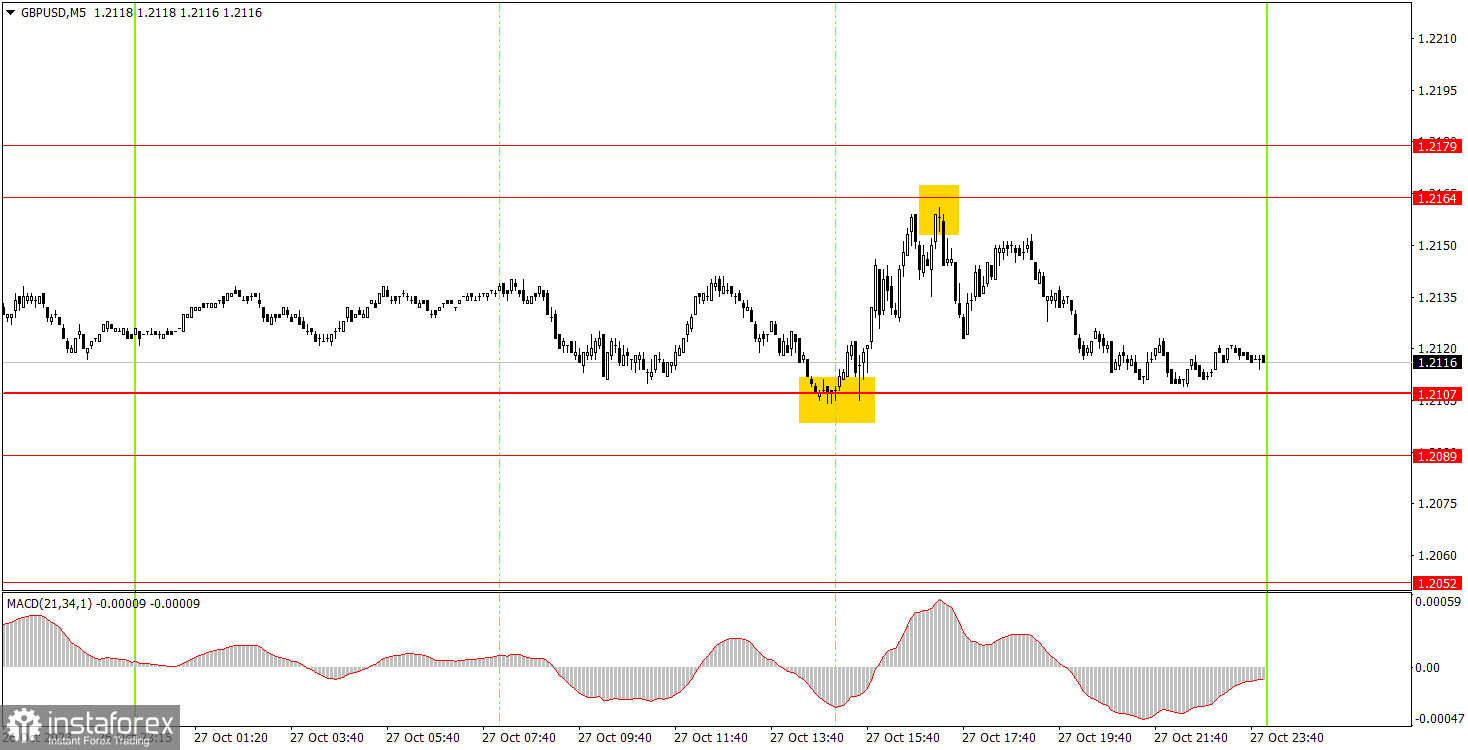Analyzing Friday's trades:
GBP/USD on 30M chart

GBP/USD edged up on Friday. It's quite challenging to determine the pair's direction at the moment. If we look at the hourly chart, it appears that the pair is mostly moving sideways. Last week, it couldn't initiate a new bullish correction due to unconvincing British reports and strong US data. In the upcoming week, we have meetings of the Federal Reserve and the Bank of England along with a slew of important reports from the United States. The pair's movements could be very tumultuous, so we should be cautious.
The pair breached the 1.2107 level, but did not fall further. In the medium term, we expect a downward movement, but in the short term, an upward correction is still possible.
GBP/USD on 5M chart

On the 5-minute chart, two trading signals were generated for the pound. Initially, the pair rebounded from the 1.2107 level, which is still important and strong, and then it rose to the level of 1.2164. Therefore, beginners could open a long position, which yielded about 20 pips of profit. The bounce from the level of 1.2164 could also be executed, and this trade brought in another 20 to 30 pips of profit. It was advisable to manually close it closer to the evening since there were no more buy signals generated. Overall, it turned out to be a quite decent trading day.
Trading tips on Monday:
On the 30-minute chart, we were expecting a new leg of the upward correction, but it ended too soon. Of course, the pair can resume the downtrend right now, but it still seems incomplete. The 1.2107 level may keep the pair from falling for the fifth time, but the pair did not fall further even after breaching this mark. The key levels on the 5M chart are 1.1992-1.2010, 1.2052, 1.2089-1.2107, 1.2164-1.2179, 1.2235, 1.2270, 1.2372-1.2394, 1.2457-1.2488, 1.2544, 1.2605-1.2620, 1.2653, 1.2688. Once the price moves 20 pips in the right direction after opening a trade, you can set the stop-loss at breakeven. There are no significant events lined up in the UK and the US. Therefore, GBP/USD will likely see little volatility, and we may not even see any trends.
Basic trading rules:
1) Signal strength is determined by the time taken for its formation (either a bounce or level breach). A shorter formation time indicates a stronger signal.
2) If two or more trades around a certain level are initiated based on false signals, subsequent signals from that level should be disregarded.
3) In a flat market, any currency pair can produce multiple false signals or none at all. In any case, the flat trend is not the best condition for trading.
4) Trading activities are confined between the onset of the European session and mid-way through the U.S. session, post which all open trades should be manually closed.
5) On the 30-minute timeframe, trades based on MACD signals are only advisable amidst substantial volatility and an established trend, confirmed either by a trend line or trend channel.
6) If two levels lie closely together (ranging from 5 to 15 pips apart), they should be considered as a support or resistance zone.
How to read charts:
Support and Resistance price levels can serve as targets when buying or selling. You can place Take Profit levels near them.
Red lines represent channels or trend lines, depicting the current market trend and indicating the preferable trading direction.
The MACD(14,22,3) indicator, encompassing both the histogram and signal line, acts as an auxiliary tool and can also be used as a signal source.
Significant speeches and reports (always noted in the news calendar) can profoundly influence the price dynamics. Hence, trading during their release calls for heightened caution. It may be reasonable to exit the market to prevent abrupt price reversals against the prevailing trend.
Beginners should always remember that not every trade will yield profit. Establishing a clear strategy coupled with sound money management is the cornerstone of sustained trading success.
 English
English 
 Русский
Русский Bahasa Indonesia
Bahasa Indonesia Bahasa Malay
Bahasa Malay ไทย
ไทย Español
Español Deutsch
Deutsch Български
Български Français
Français Tiếng Việt
Tiếng Việt 中文
中文 বাংলা
বাংলা हिन्दी
हिन्दी Čeština
Čeština Українська
Українська Română
Română

